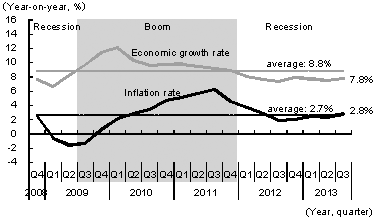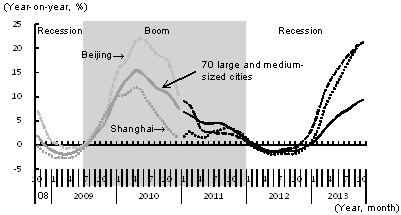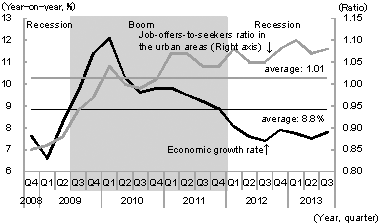In China, the real gross domestic product (GDP) growth rate (the economic growth rate) turned up in the third quarter of 2013 for the first time in three quarters, but still remained at only 7.8%. Meanwhile, the inflation rate (the year-on-year rise in the Consumer Price Index) reached 2.8% in the third quarter (3.1% in September), higher than the 2.4% posted in the second quarter and the highest since the second quarter of 2012. With housing prices also rising sharply, overheating has become increasingly evident. The current situation of overheating under low growth suggests that China's potential growth rate might have fallen significantly from its past rate due mainly to the constraints in the labor supply. Against this backdrop, Chinese authorities are expected to change their stance on macroeconomic policies, including monetary policy, from easing to tightening. Following this, the Chinese economy is likely to slow down in 2014.
Differences between the current and the previous recession periods
Since the collapse of Lehman Brothers (from the fourth quarter of 2008 to the third quarter of 2013), China's average economic growth rate has been 8.8%. Using this figure as a benchmark, the Chinese economy has returned to a recession period since the first quarter of 2012 (with the economic growth rate averaging 7.7%) after going through an earlier one from the fourth quarter of 2008 until the second quarter of 2009 (when the average growth rate was 7.5%), and a boom period from the third quarter of 2009 until the fourth quarter of 2011 (when the average growth rate was 10.0%) (Figure 1).

Compared to the previous recession period, the following characteristics have been observed in the current one.
First, signs of overheating can be seen. Although the economic growth rates do not differ much, the average inflation rate was 0.1% in the previous recession period, while this time around it is higher at 2.6%. Alongside the inflation rate, housing prices are also rising. The Price Indices of Newly Constructed Commercial Residential Buildings in 70 Medium and Large-sized Cities in China rose 8.7% year on year on average in September 2013, with those in Shanghai and Beijing surging by more than 20% (Figure 2). This is in sharp contrast to the situation in the previous recession period, when housing prices were falling.

In addition, the unemployment problem has not become serious this time. In the previous recession period, millions of migrant workers lost their jobs and had to return to the rural areas from the urban areas, following the Lehman Brothers collapse. Reflecting this, the job-offers-to-seekers ratio (the number of job offers / the number of job applicants) in the urban areas fell to 0.85 in the fourth quarter of 2008. In this current recession period, however, the job-offers-to-seekers ratio has consistently exceeded 1, showing that the number of job offers continues to be higher than the number of job applicants (Figure 3).

Furthermore, large-scale stimulus measures have not been implemented this time. Therefore, in contrast to the previous period, when the Chinese economy experienced a V-shaped recovery due to the implementation of four trillion yuan in measures to stimulate domestic demand, the pace of the economic recovery has been more moderate this time, and the recession period has been prolonged.
Reflecting the falling potential growth rate
These characteristics have a common background—the potential growth rate has fallen significantly in China as a result of the shift of labor from a surplus to a shortage due to the decline in the working-age population and the absence of surplus labor in the rural areas (the arrival of the so-called Lewisian Turning Point). Judging by the current state of overheating, China's potential growth rate appears to have already fallen to around 7%, which is not only lower than the average economic growth rates of 9.8% from 1979 to 2012 and 8.8% after the Lehman Brothers collapse, but also lower than the latest economic growth rate of 7.8%.
If the potential growth rate were the same as it was in the past, the latest economic growth rate of 7.8% would indicate that the economy is weaker than its potential. In this case, the unemployment problem would be more serious, the inflation rate and housing prices would be falling, and the government should actively implement expansionary policies to stimulate the economy. However, if the potential growth rate has already fallen to around 7%, an economic growth rate of 7.8% would imply instead that the economy is buoyant. In this case, overheating, rather than unemployment, should be a concern, and the government's stance on macroeconomic policies should be more cautious. This is exactly what the current situation is all about.
Expected shift in monetary policy to tightening
Thus, in addition to the actual economic growth rate, the potential growth rate also serves as an important reference when formulating macroeconomic policies. If the actual economic growth rate falls below the potential growth rate, the economy would dip into a recession, and a monetary easing policy would be implemented as a countermeasure. In the opposite case, the economy would overheat, and a monetary tightening policy would be implemented as a countermeasure. If the authorities insist on achieving growth higher than the potential growth rate through expansionary macroeconomic policies, it could result in the expansion of a bubble.
Based on the presumption that the actual economic growth rate was lower than the potential growth rate, Chinese monetary authorities reduced the reserve requirements three times—in December 2011, February 2012, and May 2012—and lowered interest rates twice after that, in June 2012 and July 2012, to promote economic recovery. Since then, however, they have come to recognize the fall in the potential growth rate and, in turn, the need to tighten credit, given that signs of overheating have become more and more apparent, despite the fact that the economic growth rate has remained almost unchanged. To curb inflation, the authorities have already begun to allow the renminbi to rise faster against the U.S. dollar. Since inflation is expected to accelerate going forward, the pace of appreciation of the renminbi against the U.S. dollar is expected to pick up. Hikes in the reserve requirements and interest rates are also coming into view. The full-fledged implementation of anti-inflation measures will serve as a trigger for an economic downturn.
The original text in Japanese was posted on November 6, 2013.


